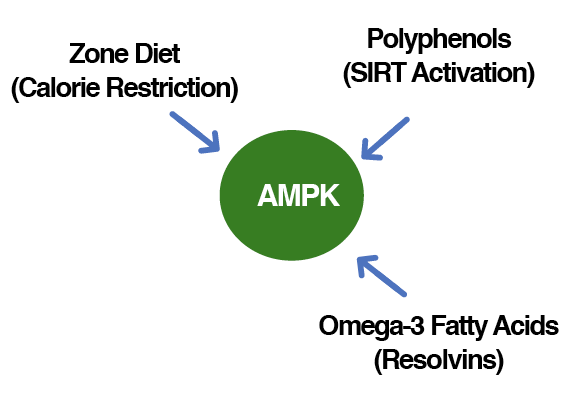What if you had a drug that would stop the replication of viruses and whose only know side-effect would be to extend your healthspan? Would you use it? Of course, you would. Such a drug is already inside every cell in your body just waiting to be activated.
That “drug” is AMPK, the genetic master switch of your metabolism. AMPK is under significant dietary control, and in particular, it can be activated by using the Pro-Resolution Nutrition system.
AMPK works at many levels of the body’s numerous anti-viral defenses (1). It is critical for maintaining the physical barriers to prevent the virus from reaching the target tissue (2–4). Likewise, it is essential for presenting viral antigens to the adaptive immune system to make antibodies (5,6). However, its most important role is that it can prevent the virus itself from replicating so that it can’t infect other cells (7–10). How AMPK works as an anti-viral drug is complicated but elegant.
Most viruses are composed of a lipid envelope the surrounds the genetic core of the virus. Viruses that have a lipid envelope include retroviruses such as those that cause AIDS, DNA viruses such as those that cause smallpox, herpes, and hepatitis, RNA viruses such as those that cause West Nile fever, dengue fever, encephalitis, yellow fever, Zika, influenza, and of course Covid-19. What this means is that the enveloped virus can’t replicate inside the infected cell unless it can hijack the machinery in the infected cell to make new lipid envelopes for themselves as they replicate. This critical point is where the activation of AMPK comes in. Once AMPK is activated, it dramatically reduces the formation of that last necessary step in viral replication.
As I stated earlier, AMPK is the master switch for your metabolism and, in particular, the synthesis of lipids. Increased lipid synthesis is controlled by another enzyme known as ACC. However, that process is inhibited if you can activate AMPK (11,12). Every cell in your body carries the molecular mechanism to stop viral replication if you can only activate AMPK.
Dietary Activation of AMPK
AMPK is under profound dietary control. It is activated by calorie-restricted diets like the Zone diet (13, 14). AMPK is also activated by the hormones known as resolvins that are generated from omega-3 fatty acids (15-17). However, the best way to activate AMPK is via water-soluble polyphenols (18), as shown below.

Not surprisingly, the three dietary components that activate AMPK are the nutritional pillars of the Pro-Resolution Nutrition system. However, they are all not equal in their abilities to activate AMPK, as water-soluble polyphenols will be the most significant effect of the three.
The reason that polyphenols are so beneficial in the activation of AMPK is that they work through a complicated pathway that activates the SIRT enzyme which activates LKB1 by deacylation, which in turn enables AMPK to be activated (19). One unique aspect of AMPK activation is the increase of the activity of the enzyme (Nampt) that makes NAD+ that in turn activates the SIRT enzyme, as shown below.

Thus, the cycle continues in a chain reaction as long as you maintain a consistent intake of polyphenols to recharge the system continuously. This complex biochemistry is all explained in greater detail in my book, The Resolution Zone (14). The bottom line is that water-soluble polyphenols can be a wonder “drug” for shutting down the replication of new enveloped viruses.
Unfortunately, there are a few problems to be overcome. First, most polyphenols are not very water-soluble, meaning they will not enter the blood at high enough levels to get into the cells to initially activate SIRT enzymes. Second, the polyphenols have to possess a unique structure to bind the SIRT enzyme (20). Of the 8,000 known polyphenols, only a specific subclass of anthocyanins known as delphinidins meet both criteria.
OK, where do you find delphinidins because you will need a daily intake of about 100-500 mg? Red wine contains some delphinidins but you would have to consume about 50 glasses of red wine per day to get enough delphinidins just to begin to activate AMPK. Blueberries are a more abundant source, but to get enough delphinidins, you would need to consume about two pounds of blueberries per day that would also supply a large amount of glucose that inhibits AMPK activity (21).
I believe the answer is finding highly purified extracts that are rich in delphinidins and devoid of glucose. Such products do exist, and they have demonstrated numerous clinical benefits that you would expect of an activator of AMPK (22–25). When highly refined delphinidin extracts are used as part of the Pro-Resolution Nutrition system, you have done your best to prepare your body to mitigate the potential damage of any virus that has lipid envelope, and that includes the SARS-CoV-2 virus that causes Covid-19.
References
13. Sears B. The Zone. Regan Books. New York, NY (1995)
14. Sears B. The Resolution Zone. Zone Press. Palm City, FL (2019)





